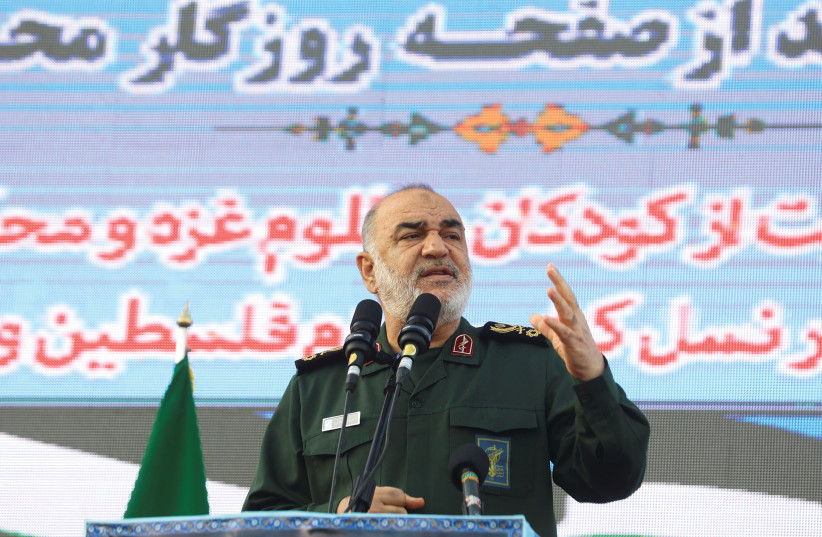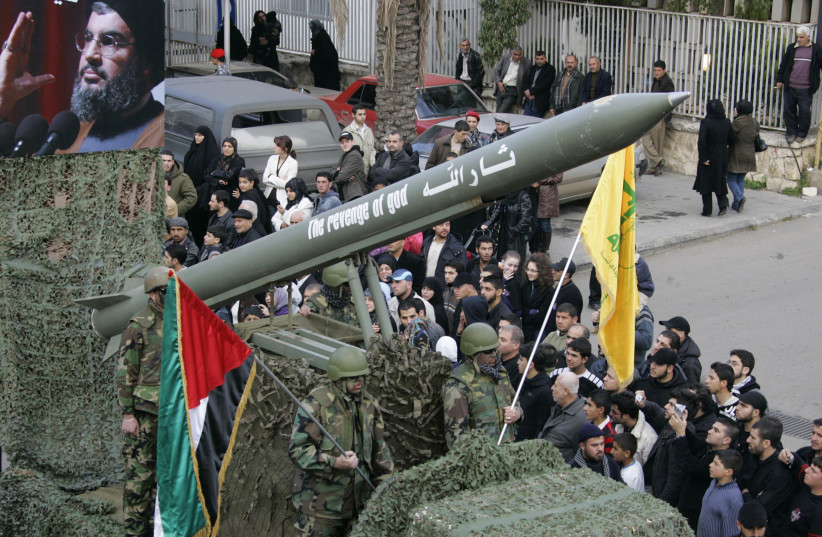
ISLAMIC REVOLUTIONARY Guard Corps Commander-in-Cheif Major General Hossein Salami speaks at an anti-Israel protest in Tehran on Saturday. The IRGC trained Hezbollah to use human shields, say the writers.
The conflict in Gaza has raised a deeply troubling issue: Reports suggest that Hamas is deliberately using civilians as shields, a tactic that echoes similar strategies attributed to Hezbollah.
This approach not only blatantly violates international warfare laws; it is also a subversion of the Quranic tradition for political and military gains. It is incumbent upon renowned Islamic institutions, scholars, and prominent religious leaders to denounce such un-Islamic actions.
Their silence risks being misinterpreted as tacit approval, casting a black stain on their moral standing and the ethical foundations they represent.
The trend of human shields
The phenomenon of terrorist groups using civilians as human shields started with Hezbollah in Lebanon. During the 2006 war with Israel, Hezbollah widely used the Lebanese civilian population as a living shield.

Hezbollah members carry mock missile during procession held to celebrate Ashura in south Lebanon, 2009 (credit: ALI HASHISHO/REUTERS)
Hezbollah members carry mock missile during procession held to celebrate Ashura in south Lebanon, 2009 (credit: ALI HASHISHO/REUTERS)
The terror group constructed a comprehensive military infrastructure (including bases, offices, weapons and ammunition stores), as well as intelligence installations within civilian population centers, private residences and public institutions in south Beirut, south Lebanon and the Beqa’a Valley. Hezbollah used these infrastructures to carry out massive rocket attacks against civilian population centers in Israel.
The construction of military infrastructures, positioned and hidden in populated areas, was intended to minimize Hezbollah’s vulnerability and to provide it with an immunity to IDF retaliatory attacks, relying on the knowledge of the IDF’s commitment to avoid harming civilians whenever possible.
Additionally, Hezbollah would also gain a propaganda advantage if it could present the Israeli army as attacking civilians
The IDF has implemented various strategies to minimize collateral damage; however, despite these efforts, the brutal tactic used by Hezbollah resulted in a significant loss of civilian lives. In the 2006 war with Israel, between 1,191 and 1,300 Lebanese people, mostly civilians, and 165 Israelis were reported dead, and there were up to 1,100 civilians wounded.
The war also caused severe damage to Lebanese civil infrastructure. Around 10,000 private homes were destroyed, 22,500 were severely damaged, and 73,000 were partially damaged, displacing approximately one million Lebanese and between 300,000 to 500,000 Israelis.
Similarly, Hamas – an Islamist terrorist organization and the de facto governing authority of the Gaza Strip – resorted to the same tactic of using civilians as human shields since taking control of Gaza in 2007, effectively transforming civilians into killable subjects.
Hamas resorted to firing rockets from or in proximity to heavily populated civilian areas or from facilities such as schools, hospitals, and mosques, which normally should be protected according to the Geneva Convention. Hamas also located its military headquarters, bases, armories, access routes, lathes, and defensive positions within or in proximity to civilian areas.
As the IDF entered Gaza in response to Hamas’s brutal attack on Israel on October 7, it found a series of shocking embedding practices by the terror group. For instance, the IDF found that Hamas placed rockets inside a little girl’s bed and anti-tank missiles inside a baby stroller, as well as a weapons factory, weapons, rocket launchers, and massive terror tunnels adjacent to a school and within a mosque.
The IDF troops also found countless weapons concealed in Shifa Hospital’s MRI building. Hamas has also been reported to use hospitals as hideouts for detaining Israeli hostages. For instance, beneath Rantisi Hospital in Gaza, IDF forces discovered a room used for holding Israeli hostages.
A tunnel appeared to lead from a Hamas member house to Rantisi Hospital, and next to a school and a UN building. The IDF also discovered a significant 55-meter-long tunnel, 10 meters underneath the Shifa Hospital complex, during an intelligence-based operation. Additionally, within the Shifa Hospital complex, IDF troops discovered a covertly placed vehicle rigged with booby traps, containing an extensive cache of weapons, explosives, and various equipment.
These documented instances align with Hamas’s public rhetoric advocating the use of civilians in conflict. In 2006, a Hamas leader said, “The citizens will continue defending their pride and houses and will continue to serve as human shields until the enemy will withdraw.” In 2014, Hamas spokesman Sami Abu Zuhri said that “the fact that people are willing to sacrifice themselves against Israeli warplanes…means this strategy [of using civilians as a shield] is proving itself. And we, Hamas, call on our people to adopt this practice.”
On another occasion, Abu Zuhri told Al-Aqsa TV that “Hamas despises those defeatist Palestinians that criticize the high number of civilian casualties. The Resistance praises our people…we lead our people to death…I mean to war.” Former Hamas leader Khaled Mashaal told Al-Arabiya, “Russia, Vietnam, Afghanistan, Algeria, all sacrificed millions of people in wars. Palestinians will have to do the same.”
By engaging in these acts, Hamas’s goal is to either force the IDF to limit its use of military power to minimize collateral damage or to push the IDF to use kinetic power in order to surge the number of civilian causalities, so that it can use that as a weapon in its propaganda and accuse Israel of committing war crimes.
This brutal tactic has cost many civilian lives. According to data gathered by the UN, in 2014, during Israel’s military campaign dubbed “Protective Edge,” at least 2,133 Palestinians were killed in Gaza; 1,489 were believed to be civilians, including 500 children. In addition, approximately 18,000 housing units were either destroyed or severely damaged, leaving over 108,000 people homeless.
The architect of this embedding asymmetrical tactic was the Islamic Revolutionary Guards Corps (IRGC). When the Islamic regime in Iran formed Hezbollah in Lebanon, the IRGC started to train the terror group to use the civilian population as human shields in addition to several other asymmetrical tactics such as kidnappings, hijackings, planting roadside bombs, and suicide bombings (also known as the poor man’s smart bomb).
The IRGC trained Hezbollah and, later on, Hamas to use the civilian population as human shields and to disperse weapons, infrastructure, and fighters among the local population, including in houses and public institutions such as mosques and hospitals. By hiding among civilians, the IRGC and its terror proxies forced Israel to choose between suboptimal tactics and international law, which demanded proportional response to provocations.
Ayatollah Khomeini, the founder of the Islamic regime in Iran, and his successor, Ayatollah Khamenei, blessed the tactic and stipulated that this would give Muslims the opportunity to achieve martyrdom.
A violation of Islamic teachings
However, the embedding tactic, as well as the Khomeini and Khamenei stipulations, is un-Islamic and a clear violation of the teaching of Islam, both in the Quran and Hadith. The Quran includes principles that emphasize the protection of civilians and non-combatants who are not participating in war, including women, children, the elderly, and the clergy, as well as the sanctity of nature and property.
Surah Al-Ma’idah (5:32), in particular, indicates the importance of protecting civilians and ensuring justice, and it sets a precedent for the value of human life. Additionally, Islamic jurisprudence and the rules of engagement (Qawa’id al-Ahkam al-Shar’iyyah fi al-A’mal al-Askariyyah) emphasize the protection of civilians.
Nahjul Balagha, the book of Imam Ali ibn Abi Talib, the first Shia imam and cousin and son-in-law of the Prophet Muhammad, touches upon the treatment of the enemy and stresses protecting the dignity and well-being of non-combatants. In Letter 47, which Imam Ali wrote to Malik al-Ashtar, whom he appointed as the Governor of Egypt, he emphasizes justice and compassion towards others, which can be extrapolated as a condemnation of any act that would harm or misuse civilians during conflict.
Clearly, Hamas and Hezbollah’s use of civilians as human shields is not only a serious violation of international laws of war, but it also stands in stark contradiction to the teachings of the Quran. Renowned Islamic centers such as Al-Azhar University, prominent theology scholars such as Grand Imam Sheikh Ahmed Al-Tayeb, and Shia religious leaders such as Ayatollah Ali Sistani are expected to denounce this inhuman, brutal, and un-Islamic act. Their silence can be interpreted as an implicit support for human shields, a black stain on their moral integrity.
Farhad Rezaei is a senior fellow at Philos Project. Sadaf Rostami has a bachelor’s degree in political science from York University. Siavash Gholami holds a master’s degree in political science from the University of Toronto.
News Related-
Window opens for Zahid to ride off into the sunset – but at Anwar's cost
-
Murder-accused teens 'had preoccupation with torture'
-
Strengthen MM2H programme, promote multiple entry visa
-
GEG element removed from anti-smoking Bill
-
Health Ministry tables revised anti-tobacco law, omits generational smoking ban
-
Work together with Anwar to tackle economic issues, Perikatan MP tells Muhyiddin and Ismail Sabri
-
Malaysia Airlines launches year-end sale
-
Dr M accuses govt of bribery over allocations
-
Malaysia to check if the Netherlands still keen to send flood experts
-
Appeals court to rule in Isa’s graft case on Jan 31
-
Elephants Trample On Axia With Family Of Three Inside
-
Sirul fitted with monitoring device
-
Nigerian airliner lands at wrong airport
-
Big market marred by poor upkeep
